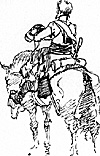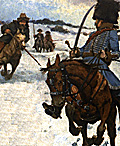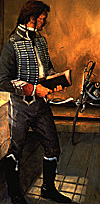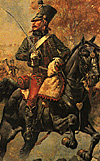| The following material covering Napoleon's cavalry, focusing on the light cavalry and hussars in particular, was excerpted from Swords Around a Throne by Colonel John R. Elting (AUS, Retired). One of several important works on military history authored or edited by Col. Elting, this comprehensive volume published in 1988 examined every aspect of Napoleon's Grande Armee. David Chandler described Elting's book as "A masterpiece: quite simply . . . the best I have ever read on this challenging subject." Elements from the book are reprinted with the permission of Simon & Schuster, which now owns the rights to the original Free Press edition. Additional information on French hussar organization and uniforms was researched and appended by members of the staff of Napoleon magazine. Where appropriate, Col. Elting's numerous footnotes were incorporated into the article in the interest of saving space and presenting the reader additional pertinent information on the Hussars. |
|
Introduction
The French cavalry, on the whole, had been damnably misused through the Revolutionary Wars, parceled out by regiment and squadron through the infantry divisions, and there too often used up in galloping after generals as escorts and orderlies. Its best men and horses had been drawn off into the numerous units of guides. New light cavalry units with amazing uniforms and astounding names -- Hussars of Death, the Light Cuirassiers and Mounted Pikemen of the German Legion, American Hussars, Hussars of Liberty, Hussars of Equality and Fraternity, Revolutionary Chasseurs, and the Eclaireurs de Fabrefond got most of the Volunteers. (The Light Cuirassiers were armored in chain mail and buff leather; the American Hussars originally contained many officers and men from the French West Indies, including at least a company of blacks. Many of these units had at least two names, to the tribulation of researchers. Beginning in 1793 such units were gradually converted to, or put into, regular regiments.)
Unfortunately, few of those eager patriots, officers included, had even vague notions of equitation and hippology or had ever dreamed that being a dashing cavalryman should involve a lot of hard work with curry combs and stable brooms. One sour-minded veteran noted that such green-horn heroes might drop their sabers to hold onto their hats.
By 1800 most of the army had the look and deportment of under-priveleged ragpickers. Even regiments of old renown had trouble keeping up their appearance and morale. In the Armee d'Italie it was said that you could identify a hussar only by his long mustaches; the colonel of the 3rd Hussars was horrified to discover that some of his men had degraded themselves even so far as to shave those off. Concurrently they had become slovenly and insubordinate; they failed to salute officers, and his oldest veterans were the worst offenders. Even worse, they had fogotten how to swagger and walked slouched like a lot of sacre civilains! He demanded uniforms for them: If their traditional silver-gray rig with its scarlet braiding couldn't be supplied, he would accept light blue, but they must be decent outfits a soldier could take pride in wearing.
On being confirmed as First Consul [14 December, 1799, validated by plebiscite in 1802], Napoleon Bonaparte inherited eighty-five cavalry regiments: twenty-five of chasseurs a cheval, thirteen of hussars, twenty of dragoons, two of carabiniers a cheval, and twenty-five of cavalerie de bataille. Of those, the light cavalry--the chasseurs and hussars--were in the best condition. As previously noted, they had attracted the pick of the recruits, and they could be mounted on the small, active horses bred in the Tarbes, Auvergne, and Ardennes areas of France. The cavalerie, originally big men on strong, big horses meant for massed charges, had dwindled into understrength collections of whatever men and mounts they could get, much battered by the ponderous Austrian cuirassiers. The carabiniers and the dragoons were in little better shape. De Brack would complain that Napoleon was no cavalryman, that he expected horses to carry excessive weights, live on short rations, and keep going without rest. But Napoleon did know how to organize and use cavalry effectively. Beginning in Italy in 1796 with his first independent command, he extricated his mounted units from his infantry divisions to concentrate them under his personal control. As First Consul and Emperor he did likewise with the whole French Army, accumulating the famous "Cavalry Reserve" that Murat would lead in glory. To restore the efficiency of his heavy cavalry, Napoleon abolished seven of the cavalerie regiments, putting their men and horses into the remaining eighteen to bring those up to strength. The first twelve got the biggest troopers and all the tall horses; the other six were converted to dragoon regiments, which, according to regulations, had smaller horses and lighter men than the cavalerie. At the same time Napoleon also made dragoons out of the three newest hussar regiments. Their officers were thoroughly unhappy: They had to provide themselves with bigger horses and replace their sabers with straight-bladed thrusting swords; moreover, dragoon uniforms not only were an unexpected expense but totally lacked the glamour of a hussar outfit!
 Keith Rocco's illustration of a French hussar of the Revolutionary period. © Keith Rocco.
Keith Rocco's illustration of a French hussar of the Revolutionary period. © Keith Rocco.
Changes Under Napoleon
Though usually needing additional cavalry...
Napoleon considered it more practical
and economical to increase the number of
squadrons in his existing regiments
rather than create new ones
Another cavalry innovation during the Consulate was the creation in 1801 of an elite company of picked men in every regiment of hussars, chasseurs, and dragoons, to be the equivalent of the infantry's grenadiers. Their NCOs and men got the "sou of the grenade," bearskin caps, and scarlet plumes and epaulettes. (The elite company was always the 1st Company of the regiment's 1st Squadron.) The caps varied in style from regiment to regiment; in 1811, for economy's sake, they were ordered replaced by special shakos, but many regiments were slow to give them up. Elite companies were specially charged with guard of their regiment's eagle. On campaign they frequently were detached as escorts for corps commanders, much to their colonel's disgust. The standard cavalry regiment of the Consulate and early Empire had four squadrons, each of two companies, which in turn were subdivided into two platoons. The companies varied in strength according to their "arm"--four officers and 140 men for hussars and chasseurs. There was a small regimental headquarters with the usual administrative, medical, and service personnel: the colonel, the major, two adjutants, a quartermaster, a surgeon and two assistant surgeons, a trumpet-major and trumpeter-corporal, a veterinarian, a master farrier, a saddler, an armorer, a cobbler, and a breeches-maker for the leather breeches worn by heavy cavalry and dragoons. Regiment and company strengths constantly varied. Most regiments added a small detachment -- six to eight select men -- trained and equipped as sapeurs. Like infantry sapeurs, they wore beards, bearskin caps, and heavy aprons; had elite status and pay; and carried pioneer tools. In the field they opened roads, improved campsites, and demolished obstacles; otherwise they served as regimental headquarters guards and orderlies. Though usually needing additional cavalry, especially after his occupation of Spain in 1808, Napoleon considered it more practical and economical to increase the number of squadrons in his existing regiments rather than create new ones. In 1806 all regiments received a 5th Squadron, intended for service at the regimental depot, where it would train recruits and remounts and serve as replacement depot under the regiment's major but also would be available if needed. Some light cavalry regiments were gradually increased to six, seven, or even eight squadrons. The Ulm and Austerlitz campaigns of 1805 were the first test of the new Napoleonic cavalry system and the first of its triumphs. Except for the necessary minimum of light cavalry assigned to each of the Grande Armee's six army corps, all mounted units were concentrated in the Cavalry Reserve, which included all the heavy cavalry and dragoons and the remaining light cavalry. (Each army corps had a division, usually three or four regiments, of light cavalry. Murat's Cavalry Reserve had two divisions of heavy cavalry, four of dragoons, one of dismounted dragoons, and one of light cavalry.) The light cavalry formed a screen behind which the Grande Armee maneuvered, hunting down the enemy and driving in the enemy cavalry's scouts and patrols. Though Napoleon's concept of cavalry organization and operations had proved itself by 1807, several weaknesses were apparent. The Emperor would labor to correct them for the rest of his reign. More light cavalry was necessary as Russia brought its endless swarms of mounted men into the wars, and especially more lancers.
Hussars differed from chasseurs a cheval in little except their dress and hairdos. Amazing elaborations of the original Hungarian fighting rig, their swinging pelisse, tight dolman and breeches, plumed shako or busby, light boots, dangling sabretache, and jingling spurs--all braid, bright buttons, fur trimmings, and lace--could make the most downy-lipped hobbledehoy into the likeness of a hero and a confirmed breaker of female hearts. Consequently, the style was much favored by young aides-de-camp. With that uniform came an advanced state of elegant masculine hairiness: long mustaches, queues, and braided love locks (called cadenettes) worn dangling in front of each ear and weighted at their ends with bits of lead to make them hang straight. Veterans might substitute gold coins as a ready savings account against days of need. Young recruits, Marbot recalled, were fitted with false pigtails and cadenettes of horsehair and mustaches made by liberally applied boot polish until they could raise their own. (Later, most hussar regiments would abandon queues and cadenettes during the latter half of the Empire's existence, but the mustaches flourished.) Each regiment had its especially showy elite company, and hussar trumpeters, musicians, and sappers were a glory seen afar, even on cloudy days.
At their beginnings, hussars had been an irregular sort of Hungarian light horse, specializing in "small war" operations rather than pitched battles. Their weapons were a heavy, decidedly curved saber, carbine, and pistols. The first French hussars, authorized by Louis XIV in 1692, were refugees from an unsuccessful Hungarian revolt against Austrian rule.
By the beginning of the French Revolution in 1789, the six existing hussar regiments were strongly Germanic in character, made up of "Germans" from Alsace, Lorraine, and the Rhineland. (In 1788, one Michel Ney was such a recruit.) In the 1st Regiment (ex-Hussards de Bercheny) the "word of command" (orders) was in German until 1793, and in frequently fractured French thereafter. Replacements, however, were increasingly French. Between 1792 and 1801 the 1st Hussars claimed a record of thirty-seven battles, 168 lesser engagements, and 1,040 skirmishes, with 26,300 enemy soldiers, forty flags, and 303 cannon captured. In that same period, the regiment had been used up and rebuilt some five times, absorbing men from assorted Volunteer units. The replacements included four companies of the "Light Cavalry of Calvados," one company of the "Light Dragoons of the Mountain," and elements of the 18th Chasseurs a Cheval, the 26th Cavalerie, and the 13th Hussars. In 1796, Napoleon's chief of cavalry, the somewhat dubious Irishman General Charles Edward Kilmaine, wrote the worse-than-dubious Colonel Jean Landrieux of the 13th Hussars that the 1st Regiment was part German and part French, and was carrying on a private civil war between battles.
When Marbot joined as a volunteer in 1799, practically all the sergeants and corporals were still "Alsatians" who spoke a jargon of their own and could not read French. Some of those tough old sweats, including the "bad" Sergeant Pertelay, Marbot's mentor when he joined the regiment, were still following the wars into Prussia, Poland, and Spain nine years later. Troopers of the two oldest regiments, which continued to draw their recruits from France's eastern frontier, still called them by their former Royal Army titles, "Bercheny" and "Chamborant," rather than by their numbers.
In 1810 Napoleon acquired an 11th Hussar Regiment with the absorption of the Dutch Army into French service. The next year he put together several detached hussar squadrons in Spain to form a 9th (bis) Regiment, redesignated the 12th Hussars in 1813. Also in 1813 he raised a 13th and a 14th regiment in northern Italy; those, however, were soon destroyed or captured in Germany. To replace them, he lumped their recruits, cadres, and escapees into a new 14th Hussars in 1814 and took back into French service as the 13th Regiment the "French Hussars of Jerome Bonaparte," who had been briefly part of that feckless play-King's guard. The Regiment was formed in August 1813 out of recruits en route to French cavalry regiments in Germany to stiffen Jerome's dubious West-phalian guards. Probably never completely organized, it lost heavily in 1814; the survivors were assigned to the 5th Lancers.
Though hussars formed a comparatively minor part of the French cavalry, they were constantly in the public eye. Something of the old irregulars' swagger and dash went with them, "in every land, dearly beloved by the wife, hated by the husband!" (from an old soldiers' song). Most of them lived up to the reputation of their arm or literally died trying. "Noblesse oblige, Chamborant autant," the 2nd Hussars ancient motto proclaimed. One compliment among many came from the able British soldier-historian William Napier, who wrote in his five-volume War in the Peninsula and the South of France of the silver-gray uniformed 3rd Hussars he faced in Spain: "Colonel Ferriere never failed to break in upon our skirmishers in the most critical moments . . . and was continually proving how much may be done, even in the most rugged mountains, by a small body of good cavalry." The Russian campaign of 1812 seriously wounded the French cavalry, especially its heavy regiments, whose big horses were much more vulnerable to hunger and bad weather than the smaller animals of the light cavalry. The 11th Hussars, for example, reported only ten officers and seventy-nine enlisted men surviving out of its original 1,133 effectives [not quite 8 percent!].
In summation, the Napoleonic cavalry undoubtedly was at its best during 1805-7. Most of its personnel then was French; the cavalry of the Imperial Guard were few in number but highly select. Practically every corps had a good division of light cavalry, and the Cavalry Reserve comprised more than 10 percent of the total strength of the Grande Armee. The division of that army between Spain and the Empire's eastern frontier after 1808 hobbled the cavalry; the bulk of its dragoons and too many of its light horsemen would be tied up in the Iberian Peninsula from then on. The lack of sufficient light cavalry during the 1809 campaign was serious, though Wurttemberg, Saxon, and Bavarian cavalry partially filled the gap. By 1812 the Guard cavalry was considerably stronger, but the need to assign sufficient cavalry to the increased number of corps left the Cavalry Reserve proportionally weaker and required a heavier reliance on allied horsemen, including Poles, Lithuanians, Prussians, and Austrians. One of France's ablest opponents in those wars, the Archduke Charles of Austria, gave his historical verdict: The French cavalry was, on the whole, poorly mounted and poorly equipped; its men were awkward horsemen. Yet it outclassed its opponents simply because, when the order rang and trumpets clarioned "Charge!" it put in its spurs and charged all out, charged home!
Beau Sabreurs: Hussar Uniform Primer The following books and primary sources were noted by Col. Elting specifically for his chapter on the cavalry.
Brack, Antoine F. de. Avant-postes de cavalerie legere. Breda: Broese, 1834. One of the most vital military books ever written, full of useful knowledge for today's soldiers.
The two following are Ministry of War publications:Ordonnance provisoire sur l'exercise et les manoeuvres de la cavalerie. 2 vols. Paris: An XIII (1804). Forward by Berthier.
Instruction sur exercises et les manoeuvres de la lance. Paris: 1811.
Colonel John R. Elting, AUS (Retired), is a member of the Napoleonic Society of America and is the author, co-author, or editor of more than a dozen military history books including Napoleon's Marshals, Napoleonic History: A Bibliography, and Swords Around a Throne.
This article appears in MagWeb (Magazine Web) on the Internet World Wide Web. Keith Rocco's illustration of a hussar of the elite company of the 1st Regiment (wearing a fur busby or colback) chased by cossacks in Russia, 1812. © Keith Rocco.
Keith Rocco's illustration of a hussar of the elite company of the 1st Regiment (wearing a fur busby or colback) chased by cossacks in Russia, 1812. © Keith Rocco.
Hussars and their Role
 Keith Rocco's study of a hussar of the 3rd Regiment standing in a room. © Keith Rocco.
Keith Rocco's study of a hussar of the 3rd Regiment standing in a room. © Keith Rocco.
Assessment
Beau Sabreurs: Colors of the Hussar Regiments (chart)
Beau Sabreurs: Hussar Regiments Campaign Duties 1792-1815 (chart)
Selected Bibliography:
Brissac, Rene de Cosse. Historique du 7e regiment de dragons, 1673-1909. Paris: Leroy, 1909.
Curely, Jean N. Itineraire d'un cavalier leger, 1793-1815. Paris: Berger-Levrault, 1887.Froberger, Georges. Souvenirs anecdotiques et militaires du colonel Biot. Paris: Henri Vivien, 1901.
Hohenlohe-Ingelfingen, Kraft K. Conversations on Cavalry. London: J. J. Keliher & Co., 1897.MacCarthy, Duque. La cavalerie francaise et son harnachmnet. Paris: Maloine, 1954.
Masson, Frederic. "Notes et documents provenant des archives du general baron Ameil," Carnet de la Sabretache, 2e Serie, Vol. V (1906) and Vol. VI (1907).
Marbot, Marcellin de. Memoires du general baron de Marbot. 3 vols. Paris: Librairie Plon, 1892. There is a splendidly illustrated abridged volume, edited by John W. Thomason, published by Scribner's, New York, 1935.
Parquin, Denis-Charles. Souvenirs du capitaine Parquin, 1803-1814. Paris: Boussod Valadon, 1892.
Preval, Claude A. H., Vicomte de. Memoires sur l'organization de la cavalerie et sur l'administration des corps. Paris: Chez Magimel, Anselin & Prochard, 1816.
Reiffenberg, Frederic de. Les regiments de fer. Paris: Ferdinand Sartorious, 1862.Sabretache (ed.). "Le manuscrit d'Angerbault du 20e chasseurs," Carnet de la Sabretache, Vol. V (1897).
___"Le general baron Desvernois et le 7e bis hussars," Vol. V (1897) and Vol. VI (1898).
___"Memoires d'un cavalier d'ordonnance du 20e dragons (1810-1814)," Vol. IX (1901).
___"Le centenaire des cuirassiers," 2e Serie, Vol. III (1904) and Vol. IV (1905).
___"Lettres et souvenirs d'un officier de cavalerie legere, 1798-1832," 2e Serie, Vol. VI (1907).
___"Campagnes et souvenirs militaires de Jean-August Oyon," 3e Serie, Vol. I (1913) and Vol. II (1914-19).
___"Souvenirs militaires de Pierre Auvray, sous-lieutenant au 23e regiment de dragons (1807-1813)," 3e Serie, Vol. II (1914-19).
Tattet, Eugene. "Lettres du brigadier Pilloy," Carnet de la Sabretache, 2e Serie, Vol. VI (1907).
About the author:
Back to Table of Contents -- Napoleon #3
© Copyright 1996 by Emperor's Press.
The full text and graphics from other military history magazines and gaming magazines are available at http://www.magweb.com
